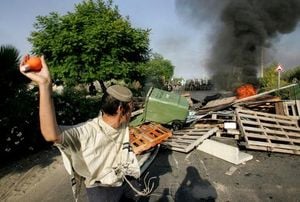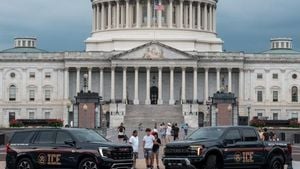In a historic move to end decades of conflict and mistrust, the Democratic Republic of Congo (DRC) and the Republic of Rwanda have embarked on a new era of cooperation, marked by a series of high-stakes meetings, peace accords, and economic integration deals. The journey toward peace, while still fraught with uncertainty and skepticism, has captured the attention of regional and international actors, all watching closely as the two neighbors attempt to chart a new course for the Great Lakes region.
The latest milestone came on August 10, 2025, when delegations from the DRC and Rwanda convened at the African Union (AU) headquarters in Addis Ababa for the inaugural session of the Joint Security Coordination Mechanism (MCCS). According to ChimpReports, the meeting was attended by observers from the United States, the State of Qatar, the AU Commission, and Togo, representing the AU mediator. This gathering marked the official start of implementing the Peace Accord signed in Washington, D.C., on June 27—a document hailed by many as a potential turning point in the region’s troubled history.
The MCCS is tasked with overseeing the “implementation of the concept of operations for the harmonised plan to neutralise the FDLR, and the disengagement of forces and removal of defensive measures by Rwanda,” as outlined in the annex to the Washington agreement. In practical terms, this means Rwanda is expected to reduce its military fortifications and deployments near the DRC border, a gesture intended to build trust and signal de-escalation. The mechanism will also facilitate information exchange between the two countries, paving the way for future cooperation and, hopefully, a lasting peace.
Both the DRC and Rwanda expressed gratitude for the roles played by the African Union, the United States, and Qatar in mediating and supporting the peace process. As the AU mediator’s representative put it, the presence of all parties in Addis Ababa “signalled a commitment to not only implement the accord, but also to build confidence between the two countries.” Yet, as observers note, the process remains fragile. Deep mistrust persists, especially amid ongoing violence in eastern DRC, where Kinshasa continues to accuse Kigali of backing the M23 rebel movement—allegations Rwanda strenuously denies.
Just days before the Addis Ababa meeting, on July 19, the two countries signed a declaration of principles in Doha, Qatar, aimed at tackling the thorny issue of the M23 rebels. The peace process has been mediated by the United States, with Qatar serving as an observer. US President Donald Trump is expected to host DRC President Félix Tshisekedi and Rwandan President Paul Kagame for a signing ceremony in Washington, a move he has described as a "glorious triumph," according to AFP. Trump’s administration is also keenly interested in securing access to critical minerals in the region, a factor that adds both urgency and complexity to the negotiations.
The international community has broadly welcomed these developments. UN Secretary General António Guterres called the Washington peace agreement “a significant step towards de-escalation, peace and stability in the eastern DRC and the Great Lakes region.” The UNHCR, the UN refugee agency, echoed this optimism, noting that the agreement “offers a chance to stop the cycle of violence and displacement and focus on solutions that restore dignity, stability, and opportunity.” Filippo Grandi, the UN High Commissioner for Refugees, reminded the world that “for decades, violence and instability in the DRC have forced millions of families to flee their homes, often multiple times, stripping them of safety and any hopes for the future.”
Despite these high hopes, the situation on the ground remains dire. UN data shows that since January 2025, eastern DRC has witnessed a new wave of violence, with the M23 armed group launching offensives in North and South Kivu provinces. In July alone, M23 rebels killed at least 319 civilians, including 48 women and 19 children, according to multiple media reports. The persistent bloodshed has led some analysts to question the viability of the peace deal. Ms Natasha Hadijjah Sebunya, a foreign policy analyst, observed, “The US is chasing their interest of gaining supremacy in this area, Rwanda is doing the same, and so is the DRC. Other players such as Uganda, Tanzania and many others that have their interests all need to be involved.”
Indeed, the inclusiveness of the peace process has been a sticking point for many regional experts. On August 1, the DRC and Rwanda signed a framework for regional economic integration, covering cooperation on energy, infrastructure, mineral supply chains, national parks, and public health. Yet, as Mr Ahmed Hadji, an adjunct professor at the Lincoln Institute of Diplomacy and International Relations, pointed out, “It is actually beyond the economic framework; there are deeper grievances that are political, sovereignty and identity. There are issues of suspicion and mistrust.” He also warned that the peace deal’s sustainability could be threatened by future changes in US administration, noting, “What if the new administration chooses to take another path? In international policy, there is what we call shift and continuity.”
Journalist Raymond Mujuni added another layer of complexity, suggesting that the deal is seeking diplomatic relief rather than offering a genuine solution. “It is unlikely that this deal will work with the current hostility that is coming in from the Goma area, which has since been captured. The impact in this is very minimal because it is not involving the real interested parties like Tanzania, Uganda and Kenya. It is not enforceable because of the complexities it comes with, and the hostilities in the Eastern DRC will always continue,” Mujuni said.
The economic aspects of the deal are also under scrutiny. Both countries have affirmed their “full, sovereign control” over natural resources and the importance of developing domestic mineral processing capacity. However, with key mineral-rich areas controlled by rebel groups such as M23 and FDLR, and with other regional players like South Africa having a stake in the outcome, the practical benefits of the agreement remain uncertain. As Mujuni noted, “The deal that was signed has a big win for Rwanda in that they would be given access to some critical mineral areas, but that is on paper. In reality, there are many players in this, and that means neither Tshekedi nor Kagame may get direct access to those areas.”
Still, there is hope that a peaceful DRC could bring much-needed stability to the region. According to figures from Uganda’s Office of the Prime Minister, the country currently hosts about 1.7 million refugees and asylum seekers, with 30.9 percent coming from the DRC. Mr Hadji pointed out, “A peaceful DRC brings about stability in the region in terms of the refugee influx it has caused to its neighbours, especially Uganda. The Congolese will find the reason to go back home and begin a new life. It will also give an opportunity to Uganda to contain the rebels of the Allied Defence Forces (ADF). It will also boost trade in the region, which will bring about economic growth as there will be free exchange of goods and services across the region.”
As the DRC and Rwanda move forward with the MCCS and economic integration plans, the world watches with a mixture of hope and skepticism. The road to peace is long and uncertain, but with sustained engagement from regional and international partners, the promise of a stable and prosperous Great Lakes region may yet be within reach.




